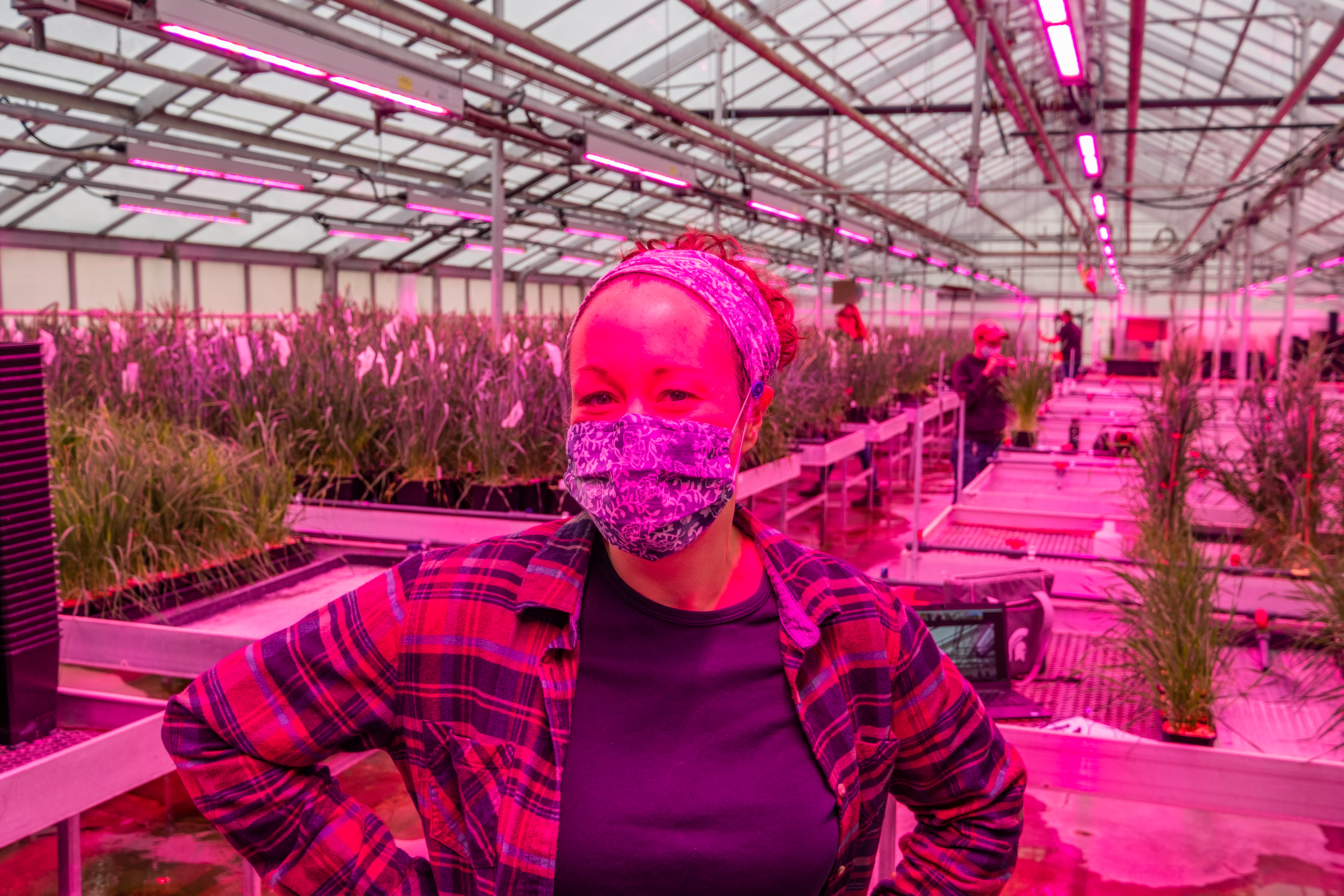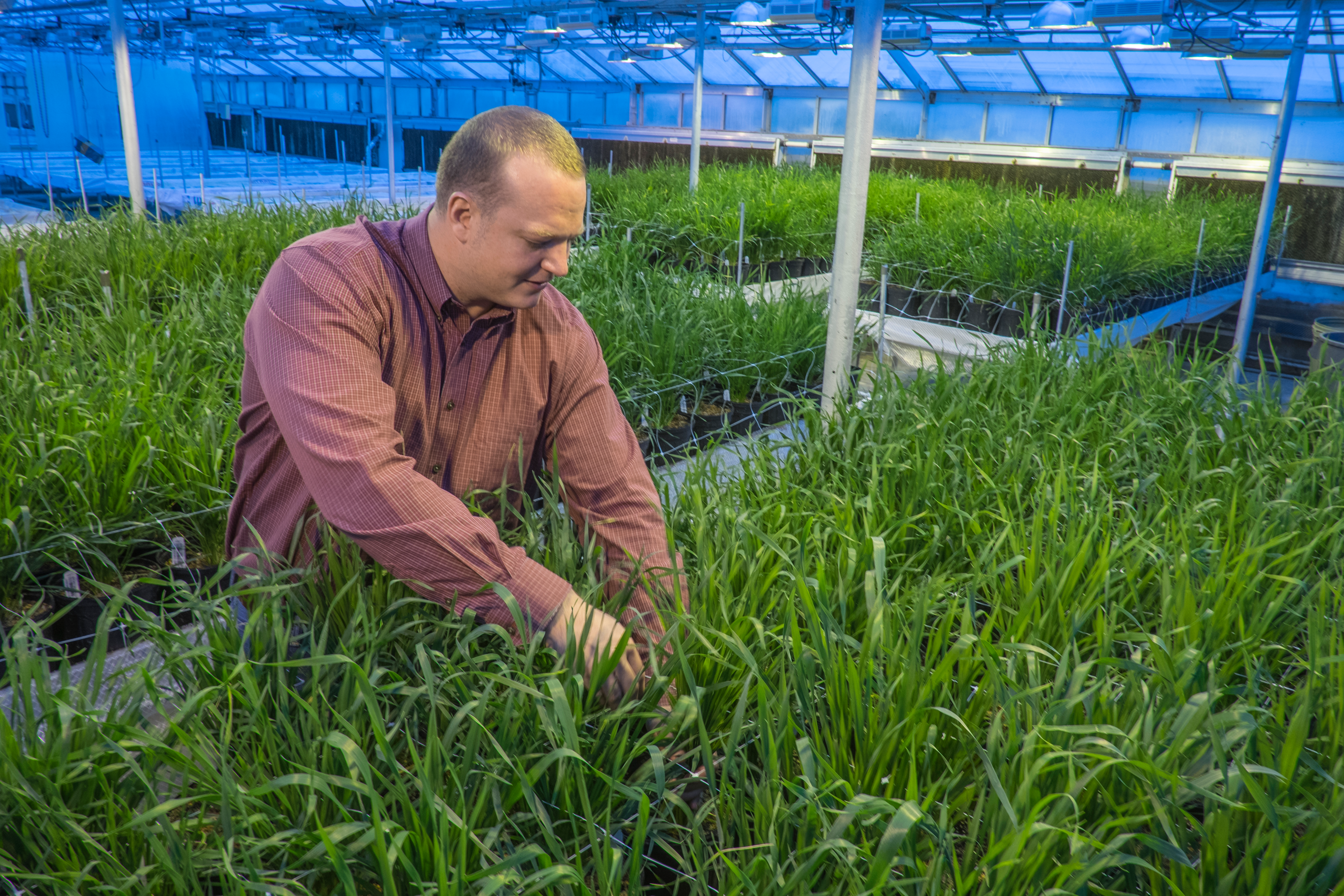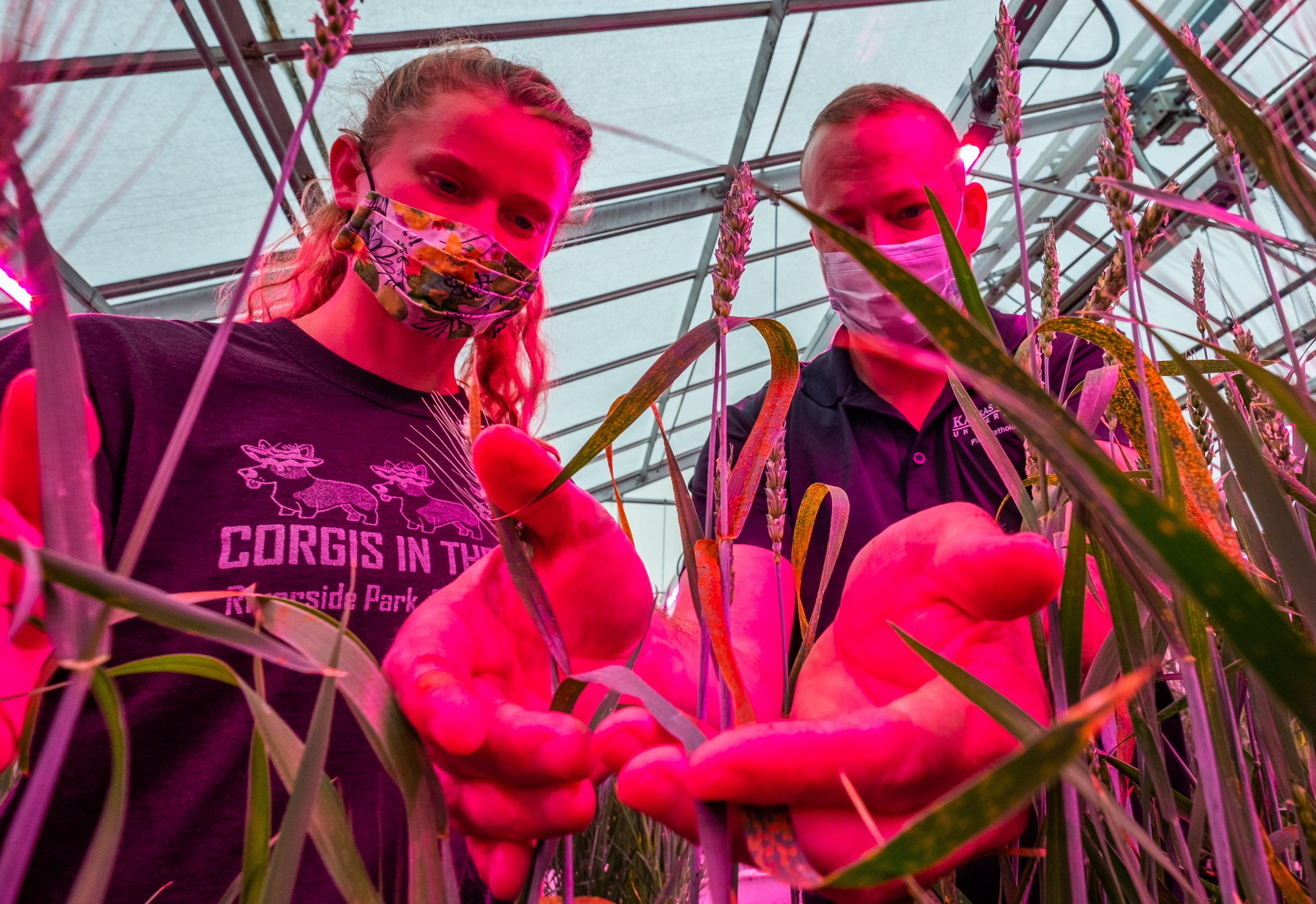Strolling through the greenhouses on the campus of Michigan State University as part of her daily routine, Chrislyn Particka is always thinking. Always planning. Always considering new and creative ways to utilize the space — and budget resources — more efficiently.
As director of the Plant Science Research Greenhouse Facility, it’s her job to ensure the operation runs smoothly for the more than 60 researchers who rely on it. She’s part plant scientist, project coordinator and budget adviser.
One of her primary objectives is to identify infrastructural improvements that can make the greenhouses more suitable for controlled experiments. Given that most buildings have gone without significant upgrades in several decades, there are a multitude of possibilities. She has teamed with MSU Infrastructure Planning and Facilities (IPF) and other units to begin forecasting what that future could and should look like.

“We’re extremely fortunate to have roughly 90,000 square feet of greenhouse space on our campus,” Particka said. “The facilities allow us to have a representation of all of Michigan’s classes of crops — from row crops and specialty crops to floricultural crops — and to conduct research that is of tremendous value to the Michigan agricultural economy.
“That being said, we’ve started to make some enhancements in partnership with IPF, including installing LED lighting and replacing steam heating in a few of the greenhouses. Not only does this improve the research, it cuts down on energy use and is therefore a cost-saving measure for the university.”
While the initial investments have been a boon to the greenhouses and the research therein, Particka said there is work to be done.
A helping hand
Particka began her role as greenhouse director in September 2019, previously serving as a research coordinator for the Great Lakes Bioenergy Research Center at MSU. Before that, she was an extension support specialist on a Specialty Crop Research Initiative grant at Cornell University, and also spent five years at a private company in the small fruit industry.
Although she had no prior experience leading a team responsible for greenhouse management, her educational background is in horticulture and plant breeding.
Particka earned bachelor’s and master’s degrees in horticulture from the University of Arkansas before completing her doctorate in agricultural and horticultural plant breeding at MSU. She studied under world-renowned berry breeder Jim Hancock, who developed some of the most widely grown blueberry lines in the world.

Despite her impressive resume, nothing could have prepared her for a global pandemic only a few months after she took the director job.
“I’ve learned a lot in a short period out of sheer necessity,” Particka said. “I have experience in horticulture, and that allows me to understand what faculty need when they do research. But navigating around workplace restrictions and the pandemic was a whole new thing for everyone. It’s been challenging, but it’s forced my team to get creative and become better problem solvers.”
Communication has been one of her most important focus areas, making sure she is in regular contact with faculty, students and staff. Other initiatives she’s undertaken are a recycling program for disposable materials, implementation of an online work request system, and nurturing relationships around the university with units such as IPF.
Using existing money from the university and potential support from other funding sources, Particka is looking to prioritize needed upgrades. Replacing the glazed-glass outer shell of the greenhouses is a long-term project, as well as updating the existing flooring to ensure proper drainage. Additionally, climate control systems that create precise experimental conditions is something she’s discussed with many researchers.
“First and foremost, I’m trying to help make researchers’ jobs easier,” she said. “The better the facilities are, the better their research will be.”
Delivering solutions to Michigan wheat growers
When Eric Olson describes the driving force behind his wheat breeding program at MSU, it starts with the greenhouses. It’s where all of the early variety development steps are completed for one of Michigan’s most widely produced crops.
“We’ve built our program on the strength of the greenhouse facility,” said Olson, an assistant professor in the Department of Plant, Soil and Microbial Sciences. “Using some new techniques, we’ve turned what used to be four years of field research into an 18-month period in the greenhouse. It speeds up variety development and allows us to get new cultivars into the hands of growers more quickly.”

According to the Michigan Wheat Program, which promotes research and outreach for wheat growers around the state, the economic impact of the crop is roughly $180 million annually. Nearly 36 million bushels are produced each year on 500,000 acres in 75 counties.
Olson was raised on a farm in Wisconsin and is passionate about assisting farmers and rural communities. To do that, he specializes in developing soft winter wheat varieties, seeking greater yield, disease resistance, stress tolerance and end-use quality.
The goal is to partner with the Michigan Wheat Program, the Michigan Crop Improvement Association, growers, milling companies and plant scientists to create profitable wheat lines for farmers that bolster food security for everyone.
“I have a deep appreciation for how connected the wheat value chain is in Michigan,” Olson said. “We have wonderful relationships all throughout the production process, from the organizations that make the work possible to growers and the milling companies that use the product. Wheat is one of the most important staple crops in the world, and it’s rewarding to be a part of ensuring its viability moving forward.”
In the greenhouses, Olson and his team cross elite-performing genetic material in hopes of combining multiple desirable traits. Generating enough seed to eventually field test requires time, space and the right environmental conditions.
Olson said the LED lighting updates have lowered temperatures in the greenhouse, allowing for more stable temperatures and a longer growing season.
He explained that plants detect changes in day length, which tells them when to flower, for example. Keeping conditions favorable to the plants for a longer period means the greenhouses can be used for more months of the year and the research is strengthened.
To advance the facilities even further, Olson is one of several researchers who have discussed climate control systems with Particka to stabilize the greenhouse environments for more controlled research over longer periods of time. He credits her efforts in identifying areas of need.
“Not only do we have great facilities, but Chrislyn has done a great job managing them,” Olson said. “She is accessible, helpful and always open to new ideas.”
But it’s not just faculty members who reap the rewards of modernizing greenhouses. Students interested in agriculture careers have the chance to participate in hands-on learning and benefit from using the latest technologies.
Melissa Winchester, a master’s student studying under Olson, spends much of her time in the greenhouse examining wheat diseases. Fusarium heat blight is the most costly to wheat growers, and others include stripe rust and powdery mildew.
MSU’s reputation for plant agriculture excellence is a major reason Winchester came to the university, and she’s used many of the same tools she’ll eventually encounter during her career. Her master’s program wraps up this summer, and she will begin searching for job opportunities.

“I’m pursuing a breeder-type role, and that means working in greenhouses for much of the year,” Winchester said. “Getting that experience at MSU in plant care and maintenance has been really awesome, working with things like lighting, irrigation systems and fertilizer applications. It has definitely prepared me for the future.”
Building on a legacy of dry bean breeding
Francisco Gomez knew there would be big shoes to fill when he agreed to lead the dry bean breeding and genetics program at MSU, beginning in March 2020. For more than four decades, Jim Kelly has been a pillar in the bean breeding community.
Rather than feeling intimidated, Gomez, an assistant professor in the Department of Plant, Soil and Microbial Sciences, has embraced the task of carrying forward a highly successful program. He knows firsthand how imperative beans are to global food security.

Growing up in Honduras, where beans are a diet staple, he became interested in plant science and the potential effect he could have on the world. His father was a plant breeder, which shaped his own career outlook.
“I’m very proud of being a second-generation plant breeder,” Gomez said. “Developing countries rely heavily on beans for sustenance, and they are critical to Michigan as well. So this is the perfect place to do this type of work and have both a local and international impact.”
The dry bean breeding and genetics program is focused on releasing varieties that deliver strong yields, disease and stress resistance, and excellent canning quality. These include navy, black, pinto, great northern and many others.
Gomez is cultivating many of the same relationships as his predecessor, connecting with industry organizations such as the Michigan Bean Commission, growers, milling companies and consumers.
According to the U.S. Department of Agriculture, Michigan is the second-largest producer of dry beans in the nation. The Thumb area of Michigan is the primary dry bean-growing region in the state and the location of the Saginaw Valley Research and Extension Center, where Gomez does the bulk of his field trials. But like Olson’s wheat lines, Gomez begins the breeding process in the greenhouse.
“We make crosses in the fall, hundreds for each market class,” Gomez said. “Each year, we are going to the field with new breeding material to make selections. This is the most important part of developing new varieties, and the greenhouses plays a crucial role in allowing us to conduct breeding activities during the winter months.
“Bean plants are very sensitive to changes in temperature and light, which can delay flowering. This can reduce the number of crosses we can make during the winter. Improvement in temperature and lighting in the greenhouses would improve the conditions during our crossing and ultimately the efficiency of our breeding program.”
While additional breeding and research activities occur in the spring, summer temperatures are too hot for bean plants to survive, demonstrating the need for greater climate control.
Gomez’s team also uses the greenhouses for disease screening of all breeding material, exposing it to pathogens such as anthracnose that devastate beans in the field. He said without the use of greenhouse space, it would be difficult to replicate this screening in the field, as it would increase the chances of contaminating a field with anthracnose.
Gomez is enthusiastic about current upgrades and plans for the future, which will benefit his program in the short and long term.
“Greenhouses in this climate are extremely important for dry beans,” he said. “We have, roughly, from October to May without the ability to grow in the field, so the greenhouse is a requirement for our breeding program. If we can extend our ability to do more in the greenhouse, we’re only going to make our breeding program more efficient.”



 Print
Print Email
Email





